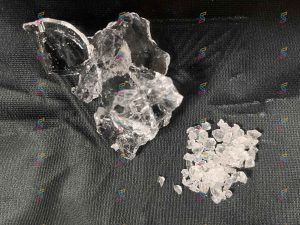Superabsorbent polymers (SAPs) are fascinating materials with a wide range of applications and significant benefits across various industries. In this blog post, we’ll explore what they are, how they work, and their uses, as well as address common questions and concerns about these polymers.

What is a Superabsorbent Polymer?
A superabsorbent polymer is a type of polymer that can absorb and retain extremely large amounts of liquid relative to its own mass. These materials can swell up to several hundred times their original weight when they come into contact with fluids.
How Do Superabsorbent Polymers Work?
Superabsorbent polymers work through a process called osmosis. The polymer network contains cross-linked hydrophilic (water-attracting) chains. When in contact with water, these chains absorb the liquid, causing the polymer to swell. The cross-links prevent the polymer from dissolving, allowing it to retain the absorbed liquid.
What are the Applications of Superabsorbent Polymers?
Superabsorbent polymers have a wide range of applications, including:
- Personal care products: Diapers, sanitary napkins, and adult incontinence products.
- Agriculture: Soil conditioners to retain moisture and improve plant growth.
- Medical: Wound dressings and surgical pads.
- Industrial: Spill control products and water-absorbent pads.
- Gel Ice Pack: Water-absorbent layers in Gel Ice Pack.
What are the Main Types of Superabsorbent Polymers?
The main types of superabsorbent polymers include:
- Polyacrylate-based SAPs: Commonly used in personal care products.
- Polysaccharide-based SAPs: Derived from natural sources like cellulose and starch.
- Polyvinyl alcohol (PVA)-based SAPs: Used in specific industrial applications.
How are Superabsorbent Polymers Made?
Superabsorbent polymers are typically synthesized through polymerization reactions of monomers like acrylic acid, which are then cross-linked to form a three-dimensional network. The polymerization process can be carried out using different methods such as solution polymerization, suspension polymerization, or bulk polymerization.
What are the Environmental Impacts of Superabsorbent Polymers?
While superabsorbent polymers offer many benefits, they also raise environmental concerns:
- Biodegradability: Many SAPs are not biodegradable, leading to long-term environmental persistence.
- Microplastic Pollution: As SAPs break down, they can contribute to microplastic pollution.
- Waste Management: Proper disposal and recycling are critical to mitigating environmental impacts.
Can Superabsorbent Polymers Be Recycled?
Recycling superabsorbent polymers is challenging due to their complex chemical structure. However, research is ongoing to develop more sustainable SAPs and effective recycling methods. Some SAPs, particularly those based on natural polymers, may offer better prospects for recycling and biodegradability.
What is the Water Absorption Capacity of Superabsorbent Polymers?
The water absorption capacity of superabsorbent polymers can vary widely, typically ranging from 100 to 1000 times their weight in water, depending on the specific type and formulation of the polymer.
Are Superabsorbent Polymers Safe for Use in Personal Care Products?
Yes, superabsorbent polymers used in personal care products are generally considered safe. They undergo rigorous testing to ensure they meet safety standards and do not cause skin irritation or other health issues.
How Do Superabsorbent Polymers Benefit Agriculture?
In agriculture, superabsorbent polymers are used as soil conditioners to improve water retention, reduce irrigation frequency, and enhance plant growth. They help maintain soil moisture levels, especially in arid regions, leading to more efficient water use and healthier crops.
What are the Common Brands or Manufacturers of Superabsorbent Polymers?
Some of the leading manufacturers of superabsorbent polymers include:
- BASF
- Evonik Industries
- Nippon Shokubai
- Sanyo Chemical Industries
- Gelsap
What are the Challenges in Using Superabsorbent Polymers in Various Industries?
Challenges in using superabsorbent polymers include:
- Cost: High-quality SAPs can be expensive.
- Environmental Impact: Non-biodegradable SAPs contribute to waste.
- Performance Variability: Different applications may require tailored SAP properties.
How Do Superabsorbent Polymers Affect Soil and Plant Growth?
Superabsorbent polymers improve soil structure and water retention, which can enhance plant growth. They reduce water stress and increase the availability of nutrients, leading to better crop yields and healthier plants.
What are the Latest Advancements in Superabsorbent Polymer Technology?
Recent advancements in superabsorbent polymer technology include:
- Biodegradable SAPs: Development of SAPs derived from natural materials.
- Enhanced Absorption: Innovations to increase water absorption capacity and retention.
- Smart Polymers: SAPs that respond to environmental stimuli like temperature and pH.
Can Superabsorbent Polymers Be Used in Medical Applications?
Yes, superabsorbent polymers are used in medical applications such as wound dressings, surgical pads, and drug delivery systems. Their high absorption capacity helps manage wound exudate and maintain a moist healing environment.
What are the Cost Implications of Using Superabsorbent Polymers?
The cost of superabsorbent polymers can be high, particularly for specialized applications. However, their benefits in terms of efficiency, performance, and reduced resource use often justify the investment.
How Do Superabsorbent Polymers Compare to Traditional Absorbent Materials?
Compared to traditional absorbent materials like cotton or cellulose, superabsorbent polymers offer significantly higher absorption capacity and retention. They are more efficient and effective in managing fluids, making them ideal for high-performance applications.
What is the Lifespan of a Superabsorbent Polymer Product?
The lifespan of a superabsorbent polymer product depends on its application and environmental conditions. In personal care products, SAPs are designed for single use, while in agricultural applications, they can function effectively for several months to years.
How Do You Dispose of Superabsorbent Polymers?
Proper disposal of superabsorbent polymers is essential to minimize environmental impact. Non-biodegradable SAPs should be disposed of in accordance with local waste management regulations, while biodegradable SAPs offer more environmentally friendly disposal options.
What are the Physical and Chemical Properties of Superabsorbent Polymers?
Superabsorbent polymers are characterized by:
- High water absorption and retention capacity
- Swelling upon contact with fluids
- Hydrophilic and cross-linked polymer chains
- Chemical stability and resistance to degradation
In conclusion, superabsorbent polymers are versatile materials with significant benefits across various industries. Understanding their properties, applications, and environmental impact is crucial for making informed decisions about their use. As technology advances, we can expect to see even more innovative and sustainable applications of these remarkable polymers.

